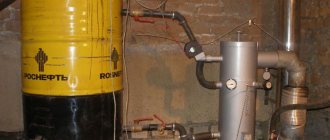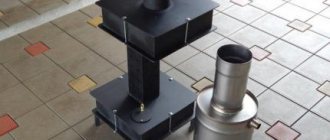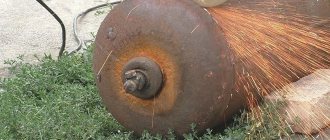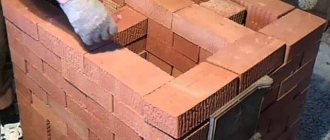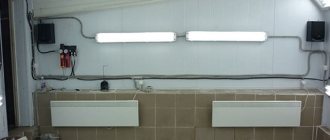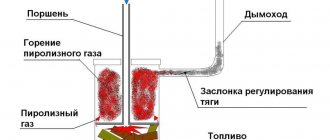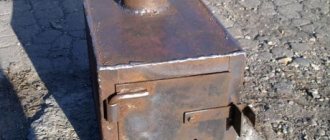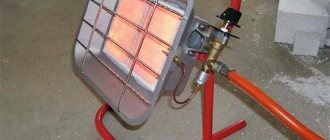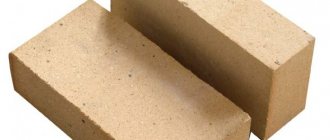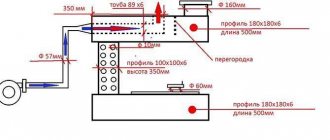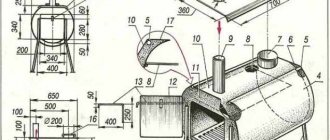How it works
The part of the cylinder that was initially cut off will be used as a waste container.
Do not forget that under no circumstances should you use kerosene or gasoline instead of oil - this can lead to an explosion. If desired, you can use the finished structure not only to heat the room, but also as a stove for cooking food. It is enough to weld a steel rectangle to the lid. Fill two-thirds of the container with oil; for ignition, you can add a little kerosene or gasoline; a rag soaked in one of these liquids will do. After 3-5 minutes, all the gasoline will burn out and the exhaust will begin to work.
After finishing use, you should clean (at least partially) the cylinder itself - just tap the lid on top of the structure thoroughly so that all the carbon deposits fall off.
Remaking a potbelly stove for working in mining
Owners of a conventional potbelly stove who decide to switch to heating with waste oil can make some changes to the design of their existing unit. When figuring out how to convert an ordinary potbelly stove for mining, you should take into account the operating principles of this unit, i.e., provide a secondary combustion chamber and air access to both chambers. Here is one option for such a modification:
- Weld a waste oil tank from sheet iron.
- Cut a hole in the stove for air supply.
- Install a valve that will regulate the flow of air into the fuel tank.
- Instead of a chimney pipe, install a pipe with air holes.
- Make a secondary combustion chamber with a removable upper part.
- Connect the secondary combustion chamber to the pipe with holes.
- Install the chimney pipe.
Of course, the vent of an ordinary potbelly stove must be closed when switching to mining to ensure proper draft. If desired, the vent and the potbelly stove hatch, through which firewood or coal is loaded, can simply be welded shut. In this case, the oil will be supplied to the furnace through a view. The oil is ignited through the same hole. However, a more convenient option for loading fuel will probably be the ability to remove the fuel tank from the stove. In this case, it makes sense to think about creating a universal stove that uses waste oil or wood.
This diagram clearly demonstrates one of the options for constructing a potbelly stove during mining. The more accurately the finished unit matches the engineers’ recommendations, the better the stove will work
How to use the oven
To decorate the stove and make it more attractive in appearance, you can make special paint. The proportions of the ingredients are as follows: for 500 g of liquid glass you will need 200 g of aluminum powder and 20 g of chalk. You get a lot of paint, so you can proportionally reduce the amount of ingredients.
After vigorous shaking, all components are mixed, and the paint can be safely applied to the stove with a regular brush.
Please pay attention to a number of safety rules when operating the oven:
The unit should be installed away from drafts; Highly flammable objects and substances should not be left near the stove; there should be about 50 cm of clearance on all sides of the stove; It is important to avoid getting water into the oil container, as this will cause boiling fuel to splash through the burner; the chimney must be tightly connected to the unit; The fuel for such a furnace can only be technical oil.
The oven warms up to operating temperatures within 5 minutes. The waste is poured into the fuel tank to 2/3 of its capacity, and about 20-30 g of solvent or gasoline is poured on top. Light the wick on the wire and use it to ignite gasoline through the oil filling hole. This will heat up the oil faster so that evaporation can begin. When the vapors ignite in the burner, you can see a stable flame, fueled by the incoming oxygen. Using a blower, you can slightly regulate the intensity of combustion.
Please note that a burning stove should not be left unattended.
Bottom of the firebox chamber and burner
I cut out the bottom from steel. I decided to make the burner 20 cm long - that would be enough.
This will be the burner
I made many holes around the circumference so that air could easily get to the fuel. Once all the holes were done, I sanded down the inside of the burner. You should definitely do this too, because... soot will begin to actively accumulate on the protrusions and other defects.
First, I welded the burner into the bottom of the upper chamber, and then installed them in their proper place. You can safely lay wood on such a stove shelf. Relevant for cases when it is not possible to replenish mining reserves.
First I welded the burner into the bottom of the upper chamber
How to clean the oven?
First cleaning
As work progresses, soot will accumulate in the burner, flue pipe and oven tray. Naturally, the stove can be cleaned only after it has cooled down.
When cleaning, I usually follow the following sequence:
- I take a couple of handfuls of clean sand or small gravel and throw them one by one into the exit of the smoke exhaust pipe from the street side;
- I remove sand or gravel with soot from the chimney through the upper chamber;
- Using a rod, I brush away the fumes from the walls of the stove burner into the lower pan;
- I take out the tray itself and empty out the waste.
I hope my experience will be useful to you, and you can assemble a stove using waste oil as easily as I did.
Good luck!
The principle of operation and advantages of such a stove
Fuel combustion in a waste oil furnace occurs in two stages. First, the fuel poured into the tank burns. The resulting gases are mixed with air. At the second stage, it is this gas-air mixture that burns, so the potbelly stove during mining consists of two compartments.
The design of the furnace for processing includes two combustion chambers, in one of which waste oil is burned, and in the other - a mixture of oil vapors and air
The first compartment is a tank into which used oil is poured. It burns at a relatively moderate temperature. Above there is another compartment, designed for the combustion of products mixed with air, formed during the combustion of waste. Here the process occurs at a much higher temperature, it can reach 800 degrees.
An important condition when building a potbelly stove for mining with your own hands is to ensure air access to both combustion chambers. For this purpose, a small hole is made in the lower tank, which serves to fill fuel, as well as to regulate the air supply. The hole is closed with a special valve. Secondary air usually enters the upper chamber through small holes (approximately 10 mm), which are drilled in the pipe connecting the tank and the second combustion chamber.
Bottom of the firebox chamber and burner
Then I made the bottom for the top compartment of the stove. For this I used a sheet of steel 4 mm thick.
I cut the bottom out of steel. I’m trying on the bottom. Everything is cut out neatly and fits together with almost no gaps. The bottom is in place.
I decided to make the burner 20 cm long - that would be enough.
This will be a burner. Drill holes. Grind.
I made many holes around the circumference so that air could easily get to the fuel. Once all the holes were done, I sanded down the inside of the burner. You should definitely do this too, because... soot will begin to actively accumulate on the protrusions and other defects.
First, I welded the burner into the bottom of the upper chamber, and then installed them in their proper place. You can safely lay wood on such a stove shelf. Relevant for cases when it is not possible to replenish mining reserves.
First, I welded the burner into the bottom of the upper chamber. Installed the burner
Making a pyrolysis furnace for mining
Now you know how to assemble a stove from a gas cylinder with your own hands. The unit running on exhaust or any oil will delight you with a lot of heat. For example, the exhaust furnace diagram presented above is designed to heat a room with an area of 70-80 square meters. m. Let's now look at the scheme for creating a pyrolysis unit - that is, a small potbelly stove.
Assembly diagram of a pyrolysis furnace operating on waste.
This oven will consist of three main parts:
- Oil container with lid and flap;
- Combustion/pyrolysis chamber;
- Afterburner chamber.
It all culminates with a chimney. Its recommended length is at least three meters, but chimneys with a height of 4-5 meters work best.
The oil container is made from a piece of pipe with a diameter of 344 mm, its height is 100 mm. We weld a sheet metal lid on the bottom. Our top cover is removable, it is made from a pipe with a diameter of 352 mm - sides with a height of 600 are welded to it. In the cover we make a central hole for the combustion chamber with a diameter of 100 mm. We make a hole nearby with a diameter of 60 mm - it will serve as a blower. This hole is closed with a simple rotating lid.
By adjusting the clearance of the blower, we can regulate the intensity of combustion, which will affect the air temperature in the room. If you completely close the vent while the stove is running, it may go out.
We make an afterburning chamber - we use a pipe with a diameter of 352 mm and a height of 100 mm. In the lower part we make a hole with a diameter of 100 mm into which the combustion chamber pipe is inserted. In the top cover we make a hole with a diameter of 100 mm for the chimney. Inside, closer to the chimney opening, we weld a small partition 330 mm wide and 70 mm high. Our do-it-yourself oven is almost ready.
It remains to modify the combustion chamber. Everything is simple here - take a drill and a 9 mm drill bit, drill 48 holes (6 rows of 8 holes each). With a total combustion chamber pipe height of 360 mm, the holes should be located in an area 20 mm from the bottom and 50 mm from the top.
After completing all the work, check the tightness of all welds - this will allow you to count on maximum efficiency of the stove.
Check the performance of the resulting unit outside. This will protect you from possible fire and other accidents.
We start testing the furnace - we install it outside, pour the waste into an oil container, and add kerosene on top. Carefully set it on fire, leaving the ash pan open. After some time, the stove will return to operating mode - you can adjust the burning intensity using the blower. After this, the stove is moved indoors (it must be ventilated).
In order for heating to be as efficient as possible, install the furnace in a corner, and line the side walls with galvanized iron so that all the heat is reflected into the room.
Gas cylinder stoves
The simplest design is for a waste oil furnace from a gas cylinder. You can also use carbon or oxygen cylinders. Their main advantage is their large wall thickness, which ensures durability of the structure.
This stove is designed to heat a room up to 90 m2. If desired, a water circuit can be connected to the heating boiler. Air injection will not be needed, and the oil will spontaneously flow into the boiler. The height of the boiler body must correspond to the height of the flame so that the boiler does not overheat during operation.
To make an oil stove from a gas cylinder, you will need:
- chimneys with an internal cross-section of 10 cm, walls up to 2 mm thick and a length of 4 meters;
- fuel tank with a capacity of 8-15 liters;
- burner pipes;
- metal corners;
- welding with a set of electrodes;
- drill and drill bits;
- Bulgarian;
- needle file;
- roulette and level.
Factory furnaces, their characteristics and features
The photo shows the factory furnace Teplamos NT-612, running on waste oil.
Before we tell you how to make a furnace for working with your own hands, we will look at several models of factory-assembled furnaces. A typical example is the Teplamos NT-612 oven. This is a typical drip fanless heater, intended for use in garages, workshops, hangars and other non-residential and technical premises. The power of the device varies from 5 to 15 kW, fuel consumption - from 0.5 to 1.5 l/hour.
Teplamos NT-612 is a closed type oven. It contains a chimney and a pipe for air supply. Combustion of fuel occurs in the inner chamber. In order for the stove to reach operating mode, it must be heated with a small amount of diesel fuel poured into a special bowl. After the fuel burns, we get a stove ready for refueling and further work - we open the waste supply and set it on fire.
The design of this unit has a built-in tank that can hold up to 8 liters of fuel.
A mini-furnace of the “potbelly stove” type is as simple as a matchbox. It is made of sheet iron and is characterized by versatility - it heats non-residential premises and allows you to cook food (small pots, pans and kettles are placed on the surface of the afterburning chamber). The power of such units varies widely. The equipment operates on the basis of pyrolysis.
Zhar MS-25 can operate on both waste oil and diesel fuel.
Let's consider a more solid stove - this is the heat generator Zhar MS-25. The unit can operate on both waste oil and diesel fuel. For its operation, electricity is required to power the built-in fan. The thermal power of the device is 25-50 kW, which allows it to heat an area of up to 500 square meters. m. In this case, the maximum flow rate is up to 4.5 l/hour. The stove is quite large, it weighs 130 kg and requires a good chimney. The temperature of the air entering the heated rooms is +50-70 degrees.
Additional features
A mini oven can serve as a boiler for heating a room and heating water for domestic needs. It is very convenient as a backup heat source in case of heating failure, breakdown of the main boiler or increased frost. In addition to garages and workshops, summer cottages and small private houses can be equipped with heaters.
The volume of the lower part of the gas cylinder is approximately 100 liters, which is quite enough to create a water circuit. To do this, the upper part of the afterburning zone is reinforced with several turns of steel pipeline: the water inside will heat up, transferring thermal energy further. To avoid a drop in gas temperature, a steel heat reflector is used to protect the coil. In this scheme, cold water is supplied from below: after heating, it will go into the circuit.
If there are several floors, then everything must be carefully thought out before installing the circuit. It is not recommended to use a heated towel rail in this scheme. The positive characteristics of single-pipe circuits are their external aesthetics, ease of arrangement and low stove consumption during exhaust. The weakness of this type of system is the inconvenience of adjusting the temperature: even if you install valves, this will be quite difficult. Often, heating systems powered by waste furnaces are installed in greenhouses and industrial premises.
Operating principle of a waste oil furnace
The prototype for oil furnaces operating on waste oil is kerogas, which was previously used in villages and dachas. It used kerosene as fuel, the vapors of which were burned in a separate chamber. To save on fuel, a waste oil burning option was developed. It can be purchased for free or at a reasonable cost at any service station.
Components of a waste oil stove
Creating a homemade stove during mining is not a difficult process. The main task is to properly organize the system for a productive oil combustion process. To ensure complete combustion of vapors, heavy components must first be split into light ones, which is carried out as a result of pyrolysis. The oil must be properly heated for efficient evaporation.
The operating principle of an oil furnace during mining is as follows. First of all, the mining is ignited in the lower chamber of the apparatus. The combustion intensity is regulated using a throttle valve in the device body, through which air enters the chamber. Oil vapor mixed with oxygen rises upward through a vertical pipe. The pipe is connected to the upper tank, which is the afterburner chamber.
The mixture is mixed under the influence of the Coriolis force (force of inertia). The intensity of the process is achieved by choosing the correct diameter and length of the combustion chamber. To ensure complete combustion, air must flow through the damper in sufficient quantity. To do this, it is additionally sucked through holes made in a vertical perforated pipe connecting the tanks.
The combustion intensity is regulated using a throttle valve in the device body
The gas flow is directed to the final combustion chamber, in which the upper part is expanded. During its manufacture, a horizontal separation is made between the chimney inlet and the combustion chamber outlet, which is necessary to ensure a temperature jump between the nitrogen oxide and oxygen afterburning zones. At temperatures below 600 °C, nitrogen oxides are more active than oxygen. As they decompose, they oxidize fuel particles. With increasing temperature, oxygen acts as the main oxidizing agent. Harmful substances are released into the atmosphere through the chimney.
How to make a stove with your own hands
Craftsmen quite often make garage stoves from old oxygen or gas cylinders. It is easy to make a compact heater tank from the top or bottom of the cylinder. Such structures are characterized by reliability, strength, and fire safety. Welding work here is kept to a minimum, because You can get by with just one seam. The presence of an annular seam on the cylinder itself, which is equipped with an O-ring, helps a lot. If a cylinder is not available, any metal vessel with a diameter of 200-400 mm and a height of 350 mm will do instead.
Along with the waste container, you will also need a pipe for transporting the air-fuel mixture, the wall thickness of which must be at least 4 mm. This role can be performed by any pipe of the required diameter, equipped with welded cones made mainly of 4 mm structural steel. The dimensions of the furnace for testing during independent design must be strictly observed. If for some reason they need to be changed, then this can only be done proportionally, and within 20 mm.
Of particular importance when assembling the heater is the quality of fixation of the funnels. The joining seams must be welded very well, since these areas during operation experience the greatest impact from the air-fuel mixture heated to a significant temperature. The chimney pipe, as a rule, has a length of no more than 350 cm. If the length is made longer, this will provoke an increase in draft, which, in turn, will begin to pull part of the waste outside the firebox. As a result, fuel consumption will increase and heat transfer will decrease.
How to weld a simple stove
If we talk about a simple heater, then a detailed drawing gives a complete idea of what needs to be done to assemble it yourself. To do this you will need rolled metal, a pipe, a sheet of iron. Tools – drill, cutter, welding machine. It is a little more difficult to produce a bent afterburner, which is necessary for the furnace to operate with greater productivity. The standard angle is 90 degrees. More is possible, but no sharper. The achieved effect is simple - retention of hot exhaust air.
Then the heat is released in greater quantities into the room, rather than being “thrown out” to the street. Another upgrade is to make an iron drawer. Oil is poured into it. With this design, the stove is easier to maintain. The drawing contains all the necessary dimensions. Before assembling a homemade oil stove, it is necessary to select the correct diameter of the firebox and body.
Here everything depends on the volume of the room that needs to be heated. If it is a garage of 3 by 6 meters, take a profile of 80x80x4 mm. The fuel box is made of metal 60x60x4. It is more difficult to work with round rolled metal.
The step-by-step instructions look like this:
- Cut the metal according to the drawings to make a casing, drawer, afterburner. If the latter has a bend, the tube is cut at an angle of 45 degrees.
- For a profile of a smaller standard size, one wall is cut out with a grinder. Plugs are welded to the sides. The result is an open container to which you need to attach a handle.
- The structure is welded. It is necessary to drill an air hole at the top of the fuel chamber. The pipe is perforated. At this point the work is completed.
It should be taken into account that you need to calculate the number and diameter of holes in the afterburner. If you use a profile of 80 by 80 mm, then the cross-sectional area will be equal to 6400 square millimeters. This value is divided in two
Pay attention to the markings of the drill used. If it is 8 mm, then the hole area will be 50 sq. mm
Now 3200 must be divided by 50. The result is that 64 holes will be required to work effectively. However, as a result of customization, their number can be increased.
It is important that the chimney is of sufficient length. The elevation of the chimney outlet must be at least 5 meters
Then the operation of the stove during testing will ensure the highest possible efficiency even without supercharging. Otherwise, the pipe will have to be extended to this mark. But you can further increase productivity if you organize an inclined chimney running along the wall. The heated metal will release heat into the room. Only in this case is it important to follow fire safety rules. There should be no wooden shelves above the pipe, and no wallpaper on the walls. Even better is to cover the wall with a metal sheet.
Making a drip heater
Professionals who have assembled more than one “dripper” use old propane cylinders with a diameter of 200 mm. Oxygen ones are also suitable, since their cross section is 220 mm. the latter benefit due to thick walls. They serve for a long time, do not burn out, and accumulate heat. Pipe C-10 is also suitable if it has a wall thickness of 5 mm. An excellent option for a durable housing is pipes made of heat-resistant stainless steel alloys, alloyed chromium, molybdenum or nickel (for example, 15X1MF or 12X18H12T) with a wall no more than 3 mm. However, it is not advisable to specifically purchase this raw material due to its high cost.
Technologically, the manufacturing process is as follows:
- A flame bowl is made using a piece of pipe or ready-made steel containers. This one is pulled out through a rubber hatch, so it is not made too big.
- The openings necessary for connecting the chimney pipe and the cleaning service hatch are cut out in the body. The latter is framed and closed with a door. Bolts can be used for fastening.
- An afterburner is being made. All holes are not made at once. Usually the bottom 2-3 rows are drilled, and the rest are drilled during the setup process. If you do everything at once and there are too many of them, you will have to make a new one.
- Weld the cover with the air duct and flange. The latter is necessary for installing the fan. The fuel supply device is connected. Photo and video instructions will help here.
Now assemble all the components and connect the electrical wiring. The structure will be more stable if you make a metal frame. A heavy metal profile is suitable for this.
